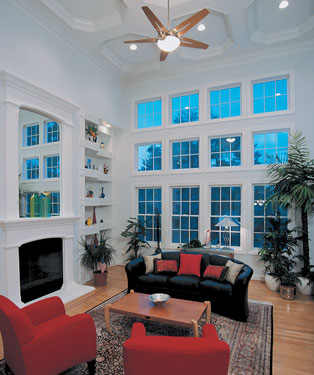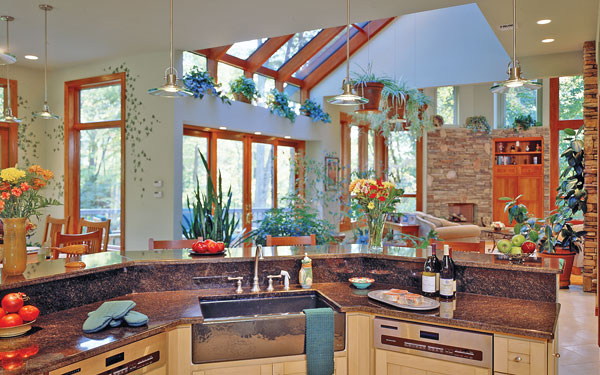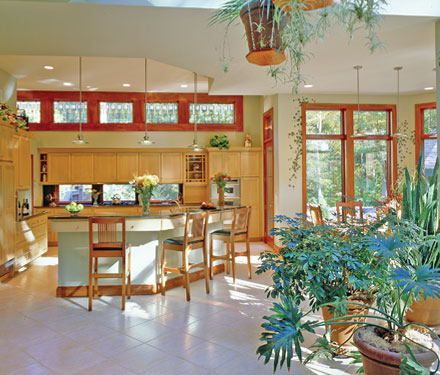by Ashley Montgomery
Proven to have a calming influence, house plants can filter out the common pollutants from your home, sharpen your focus, and often become the perfect decorations. So, with all of these beneficial effects, the only thing in the way of a happier, healthier, and more beautiful life is your black thumb.

View This House Plan to the Right
View Other Country House Plans
Under your attentive and devoted care, flowers wilt, leaves shrivel, and your plants seem to give up on living. Clearly you are making some sort of mistake, but no matter what you do, the houseplants in your care never make it past the two-week mark. So what are you doing wrong and how can you fix it?
The first step is to educate yourself about your house plants. Don’t simply rush off to the nursery and buy everything that looks pretty. It doesn’t matter if the plants look good at the nursery; trained professionals who know what they’re doing have been responsible for them thus far. Besides, without basic knowledge of light and water requirements, your poor plants won’t keep their appealing appearance for much longer. Match your plant’s needs with your lifestyle and you will finally be able to live in harmony with your leafy friends.

View This House Plan to the Right
View Other Traditional House Plans
Next, you will want to consider upkeep. Because the plants are inside and contained in pots, you need to play the role of Mother Nature. This includes watering, providing light, fertilizing, circulating the air, and monitoring humidity among other things. However, if you pick the right plants, then upkeep should be a breeze and you can finally enjoy a home filled with green, living plants.
Over-Watering
Most likely, the number one thing that you were doing wrong was over-watering. If you’re watering from above, keep sprinkling until you can see some of the water run out of the bottom of the pot. When that happens, your plants can’t soak up any more moisture, so don’t let them sit in water that they don’t want or need. Over-wateringcan lead to root rot and then all you’re left with is a brown, shriveled mess that was once a proud, lively plant.

View This House Plan
View Other Energy Efficient House Plans
Light
As we all know, plants require light in order to live and so, considering the light needs of your plants is especially important. Natural light is, of course, the best source, but fluorescent lights are also a good option. Some symptoms of insufficient light include paleness, new leaves that are smaller than normal, and stretching toward the light source. Eventually, without enough light to sustain themselves, the plants can’t use the water and again, they will succumb to root rot. For every plant, light needs vary but in general, if there is enough light to read by, then the plant will survive. If you encounter any of the above symptoms, simply move your plants into a sunnier spot and they will thank you for years to come.
Fertilization
Life as a potted plant can be rough because they are not a part of the natural cycles that happen in the great outdoors. Plants need nitrogen, phosphorus, and potassium for healthy growth, but the houseplant’s isolation in your home requires you to fertilize your plants. If your plants are grown in soilless potting mixes, just one fertilizer application every month will provide all of the nutrients that your plant needs to stay vibrant and healthy.

View This House Plan
View Other Luxury House Plans
Air Circulation
Again, outside, the natural temperature disparities would create the air currents necessary for ventilation but inside your home, you need to create the air movement. Near large windows, the air circulation is often sufficient due to the temperature differences, but in other locations, plants would greatly benefit from a small fan. Just be sure to avoid placing your plants in the direct path of the fan and they should be very satisfied with your care.
Humidity
In order to avoid losing water by evaporation through the pores in their leaves, many plants prefer humid air. This means that you should take care to monitor the humidity levels in your house because most plants favor a humidity level of at least 40 percent. Perhaps something you didn’t check before, the increased humidity level can mean the difference between a home full of blooming, animated plants and pale, wilted ones.

View This House Plan
View Other Luxury House Plans
Now that you know some of the basics for taking care of your house plants and finally overcoming your black thumb, here are a few hardy indoor plant ideas that even you would have a difficult time killing.
Philodendron – Able to go days without being watered, this tropical plant purifies the air in your home, removing the formaldehyde and making it a perfect houseplant. It does
require some sunlight but that can be remedied by setting the plant outside during the day.
Spider Plant – Not nearly as vicious as its name might suggest, the spider plant provides a unique aesthetic while filtering formaldehyde out of your home for only the price of bright light and the occasional watering.
Peace Lily – For the less observant, busier homeowner, the Peace Lily’s dramatic wilting makes it clear that the plant needs some water, but it doesn’t require extensive watering. Also, it will thrive in lowly lit rooms and absorb mold organisms from the air, so it is especially beneficial.
Shredding the blackness of inexperience and a lack of knowledge, you have revealed your inner green thumb and can now enjoy the home full of greenery and blossoms that you have always wanted. Or, at the very least, your house plants no longer perish after only two weeks!
Here are other related articles:
- Gardening Guidelines
- Houseplants
- Labors of Love: Landscaping
- Selecting a Garden Location
- Winterizing Top to Bottom
Save this article to:
back to top